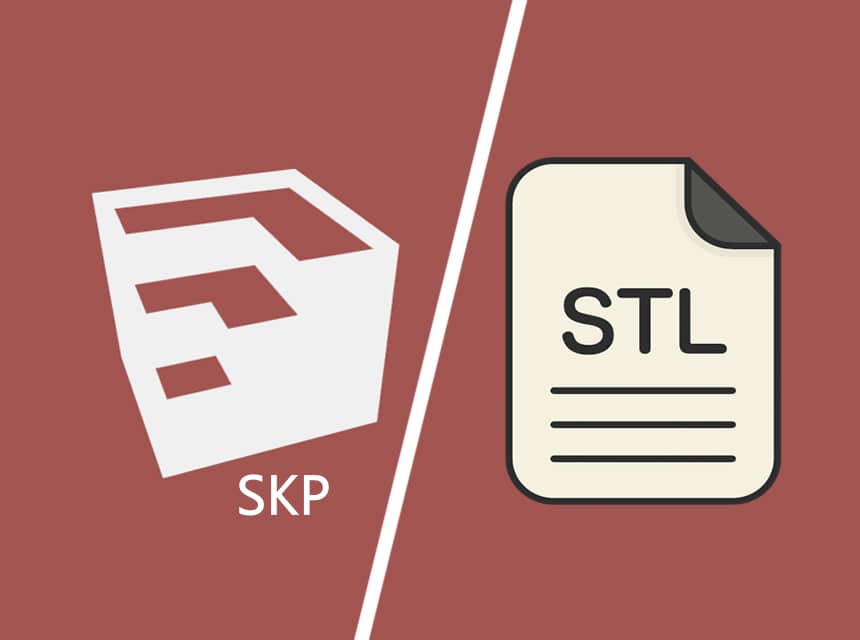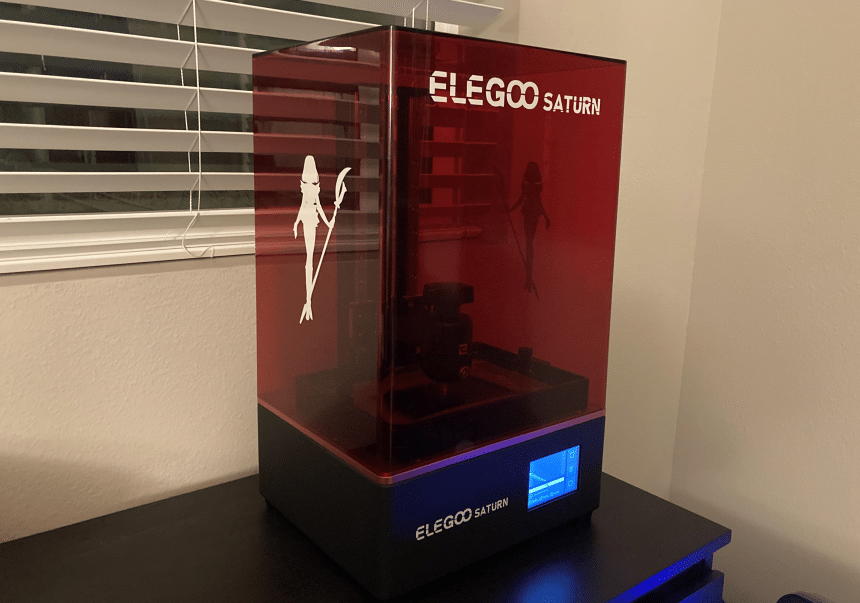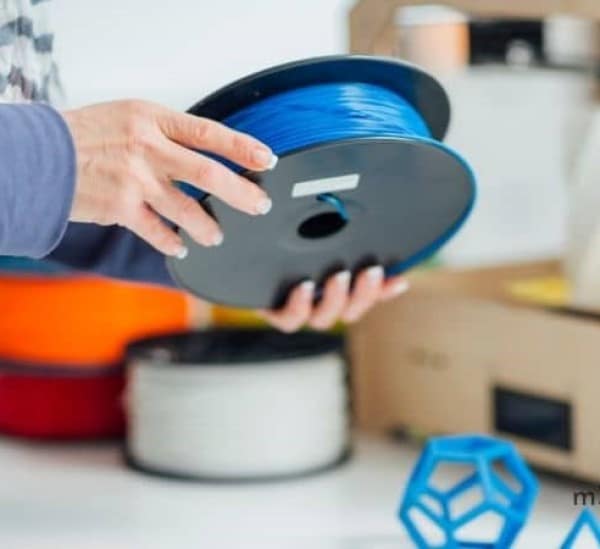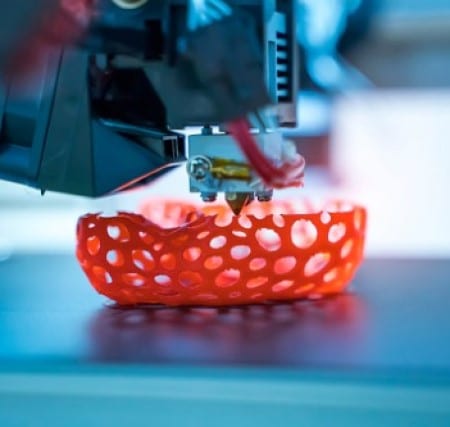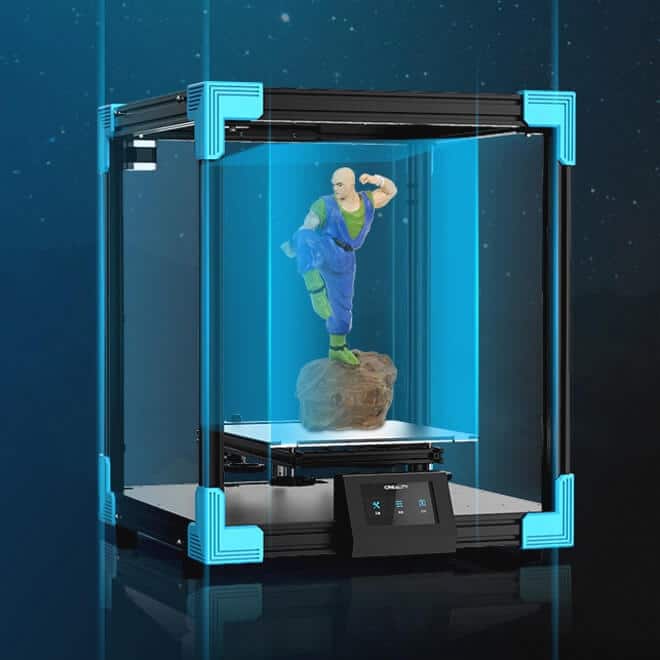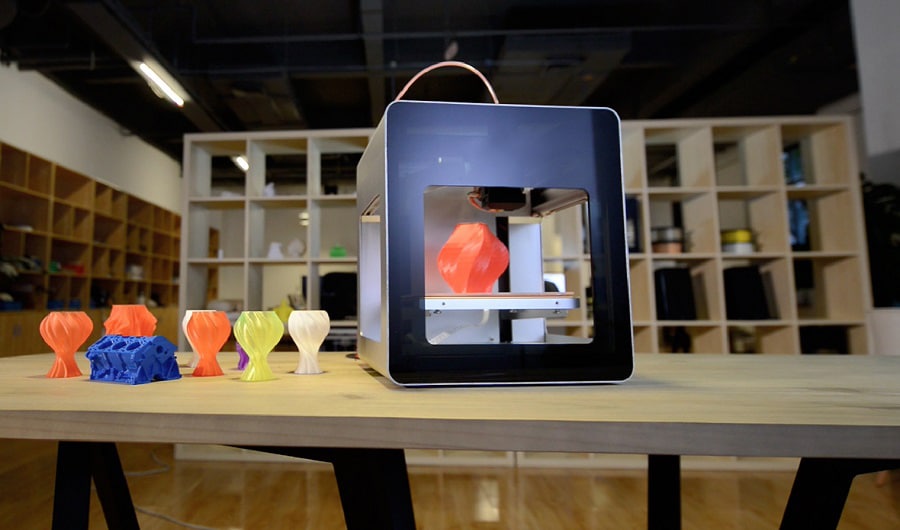

3D pens are compact and fun innovative tools that enhance creativity and fine motor skills while allowing room for errors and corrections. This is their greatest advantage over 3D printers. However, they use molten plastic, which could pose a risk for young users unless you get the best 3D pen for kids with suitable recommended age, speed control, ergonomic design, and adjustable temperature that may be lowered for safe use.
We have outlined 6 top-ranking pens that are cost-effective, cool to touch, and capable of interesting creations with different molds and colors. We selected products designed to be safe and easy to use for kids. They feature non-toxic material and non-heated external parts. We have included a couple of sets with all the needed accessories and easy-to-follow guidelines; there’s a model for smaller kids with an easy-grip handle and crank, as well as a pen for older kids with adjustable temperature and speed for more advanced projects. There are reviews of the individual features of each model and the key factors to consider before buying the best 3D pen for kids. We also discuss various ways to build your child’s skills by using this pen and other useful apps and attachments.
More features: no external hot parts; non-toxic plastic
Our Editor’s Choice is marketed as the only child-safe 3D pen. It is certainly not the only one, as you will observe in this guide, but it has taken real precautions to provide one of the best safe 3D printing pen for kids aged between 6 and 13 years. These safety measures include avoiding external hot parts and toxic plastic. Instead, 3Doodler Start Essentials incorporates a nozzle that does not heat up and 2.5mm 3Doodler Start plastic filaments, which is a biodegradable and child-friendly PCL plastic.
The 3D kit in a sustainable package includes a pen, a doodlepad, 2 packs of 48 mixed-colored strands, a micro USB charger, and an activity booklet with templates. Children can access several diverse projects and draw on the screen by using the interactive app, which has free tutorials and stencils.
The 2020 edition of this model is upgraded with refined extrusion gears for smooth flow. The plastic cooling and hardening quickly eliminates burning risk and boredom. Children are prone to short attention spans, so the plastic hardening quickly eliminates boredom as well as potential burning risk.
The manufacturer recommends using only the Company’s 3Doodler Start eco-plastic refills to optimize performance and to avoid voiding the warranty or the 365-day policy for free replacement of defective products.
What we liked: The filaments are biodegradable, malleable, and kid-friendly. The pen is locally made and compatible with a versatile app.
What could be better: The refills can be quite expensive in the long run if your child has multiple or large projects.
More features: temperature and speed control; OLED display
Our Premium Pick is not a 3D pen for kids beginners: it is specifically designed for serious artists, and older children who can work with high levels of heat ranging from 130° C to 240° C. Users fine-tune temperature in 1-degree increments and the feed flow and thickness with a speed control slider with a stepless design. Hold the button to eject the feed according to your desired speed for detailed work, double-click it to yield a continuous feed to fill in large areas, and release the button to instantly stop the flow.
MYNT3D Professional Printing 3D Pen is compatible with ABS and PLA refills with recommended working temperature of 210° C and 175° C respectively. An outstanding quality of this model is that you can even draw with bronze-infused filaments as long as they are 1.75mm in size, and they melt at temperatures of 140°C to 230° C.
Although this bestselling 3D printing pen for kids is recommended for children from the age of 7 years, it has proven to be popular with adults for mending and welding 3D prints. It also provides the best value 3D pen for kids with accessories such as a large OLED display, 3 colors of ABS plastic filament, a replaceable nozzle, 100-240V AC 50/60Hz A/C adapter, and a USB cable. You can use a 2A power bank for outdoor projects where it may be difficult to find a power outlet. The display has an intuitive interface and a high resolution that is useful for convenient monitoring of temperature settings.
What we liked: Large display, adjustable speed and temperature, multiple feeding methods, and USB charging with power banks.
What could be better: There are reports of heating failure which has resulted in replacement of the faulty pens.
More features: variable feed speed, adjustable temperature, and an OLED display
The PIKA3D Super 3D Printing Pen is an innovative and engaging tool designed to spark creativity in children. This pen transforms the concept of drawing by allowing young users to create three-dimensional objects from their imagination. Starting with basic shapes, kids can gradually build more complex and intricate designs, making it an excellent tool for developing spatial awareness and design skills.
What sets the PIKA3D pen apart is its user-friendly design, tailored for young creators. The pen comes with a ready-to-use kit, including high-quality, vacuum-packed Pika filament refills. These refills are specifically designed to be easy to handle and safe for children. The pen’s technology is advanced yet accessible, featuring variable feed speed, adjustable temperature settings, and an OLED display, which together provide a customizable and controlled drawing experience.
The PIKA3D Super is notably agile, lightweight, and compact, making it perfectly suited for smaller hands. Its ease of use is evident in its plug-and-play design, encouraging kids to start creating with minimal setup. This pen is not just a tool for arts and crafts; it’s a valuable educational resource. It can be used to aid learning in subjects like Math, Architecture, and Science, making it a multifaceted tool for both fun and education.
What we liked: The PIKA3D Super 3D Printing Pen is an excellent educational tool that goes beyond traditional learning methods. It encourages children to explore science, technology, engineering, and math (STEM) concepts in a fun and interactive way. The pen’s design is child-friendly, with safety and ease of use in mind, making it an ideal choice for young learners. The ability to adjust speed and temperature allows for a tailored drawing experience, catering to different skill levels and project complexities.
What could be better: While the PIKA3D pen is a fantastic tool for creative learning, there is always room for improvement. For instance, the durability of the pen could be an area of concern, especially when used frequently by children. Ensuring that the pen can withstand the enthusiastic and sometimes rough handling by younger users would enhance its appeal. Additionally, expanding the range of compatible materials beyond PLA could open up more creative possibilities for kids, allowing them to experiment with different textures and effects.
More features: crank can be moved for left or right-handed user
Among the featured pens, our pick for the best value 3D pen for kids has the youngest minimum recommended age of 4 years. This also makes it one of the safest pens that have passed RoHS and LHAMA compliance tests as well as heavy metal and toxicological risk assessments.
3Doodler 3D Build & Play is made from biodegradable BPA-free plastic that uses low temperature. This is a favorite feature with buyers because they can let the kids create characters with the included special molds without constant supervision.
The art kit comes with an interactive storybook. The open-ended play is designed to teach STEM and to improve the child’s imagination, motor skills, and hand-eye coordination.
Other accessories include a 3D pen, doodle molds, a storybook with backgrounds, an activity guide with 10 projects, 4 colors of 3Doodler start plastic, and an instruction manual. Kids may also use downloaded backdrops to make their own stories.
The battery is installed in the compartment at the bottom of the pen, and the top part is where you will find a power indicator light and the on/off switch. The plastic strands are fed into the pen through a hole, and the molten plastic comes out through a front nozzle when you turn the crank handle, which can be inserted on either side for right and left-handed users. The sides have labels that indicate the direction you should turn the handle to retrieve or extrude the mold.
What we liked: This is the best pen to introduce 3D drawing to kids from an early age. It is an economical model that is safe and simple to use with a right-or-left handle.
What could be better: The handle also happens to be the main drawback of this 3D pen for kid beginners. A number of buyers have complained that it is tedious to operate because of its tiny size.
More features: ultrasonic sealed nozzle is nearly clog-proof
MYNT3D Super 3D Pen solves flow issues with an upgraded ultrasonic nozzle that is well-sealed to make it almost clog-proof and a stepless speed slider to control the feed rate. Additionally, it has been approved by RoHS, CE, and FCC for adhering to the set safety guidelines.
It is one of the best rated 3D pens for older kids on Amazon. The kit includes an ergonomic 3D pen with a slim profile, ABS plastic filaments in black, blue and yellow colors, a USB cord, and a 100-240V AC 50/60Hz A/C adapter. These items are covered by a limited warranty of one year. Each plastic strand is 1.5 foot and users are guided by the included manual or the how-to troubleshooting videos on the manufacturer’s website.
The pen is designed for children aged 7 years and above. Although it does not have the OLED display of the Pro 3D pen manufactured by the same Company, it comes with a control dial with notches to alternate temperature between 374°F for PLA and 410°F for ABS plastic refills. The two models also share a replaceable nozzle and a similar gearbox.
This 3D pen uses ABS and PLA filaments, but flexy and polycarbonate refills are incompatible. The tip size is 1.75 mm. Younger kids would be more suited by low-heat models like MYNT3D Junior to avoid scalding since the ceramic tip gets hot.
Unlike majority of the best 3D printing pens for kids in this article, users have to plug the pen into a power outlet to operate it. The pen flashes a red light when it is switched on and a green light when you press the feed button to heat the plastic. If you must use a laptop to charge the pen, ensure that it can deliver the required 2000 mA.
What we liked: This 3D pen is worth every penny. We recommend it for creative art projects, smoothening blemishes or bonding multiple prints. It is safe for older kids and adjustable in speed and temperature.
What could be better: It requires to be plugged in, and the tip heats up.
To help you get the best value out of a 3D pen for kids, we have reviewed the most important features and why you should prioritize them before making your decision. This detailed guide also includes an FAQ section that briefly answers queries about working time and the different types of plastic filaments available in the market.
The best 3D pen for kids who are beginners allows them to create 3D designs on thin air and on surfaces other than paper. They can either use molds to copy the project designs in the activity guide and apps or use their imagination to draw by freehand. Replicating projects improves hand-eye coordination, and some complex designs teach kids about science, geography, technology, engineering, and mathematics. These pens are fun and educational tools that build a multitude of skills while letting kids freely nurture their imagination, individuality, and creativity. They are available in different themes for different age groups and skills.
Safety is paramount when choosing the best 3D printing pen for kids. Let’s discuss the safety measures adopted by reputable brands and other key factors that will determine durability, replay value, and usability by young users.
Confirm the recommended age to ensure it is suitable and safe for your child as the models differ in their designs, the type of plastic they support and the complexity of their creations.
3D pens come with tips that emit hot liquid plastic and small accessories that can choke toddlers.
To promote safety for young children, manufacturers use non-toxic and low-temperature plastic, non-heating external components and one setting for speed and temperature to make the best 3D pen for kids and beginners.
3D pens for older kids tend to be more complicated and better for STEM than STEAM learning. Some like MYNT3D Super 3D Pen which is designed for older children who are 7 years, or older, use high temperatures of 374°F and 410°F for PLA and ABS filaments respectively.
To provide the best value for money, 3D pen for kids come with additional accessories that differ with each model and its theme and purpose. These will typically include a 3D pen, a few plastic strands in different colors, themed molds, a micro USB charger and A/C adapter, a user manual, and an activity guide with varied number of projects.
You can purchase separate theme-based molds that are easily available in the market to increase the replay value of the 3D pen.
This constitutes a number of illustrated projects with objects that the kids should try to replicate with step-by-step directions. It provides a platform to nurture motor skills and hand-eye coordination in young users. These may include animals and cars for kids from the age of 4 years and complex buildings and 3D designs for teens.
Not every 3D printing pen for kids supports a downloadable iOS and Android app which expands your child’s resources. For those like 3Doodler Start Essentials that do, the interactive app features free tutorials and stencil section. Some allow you to receive badges and share your milestones on social media.
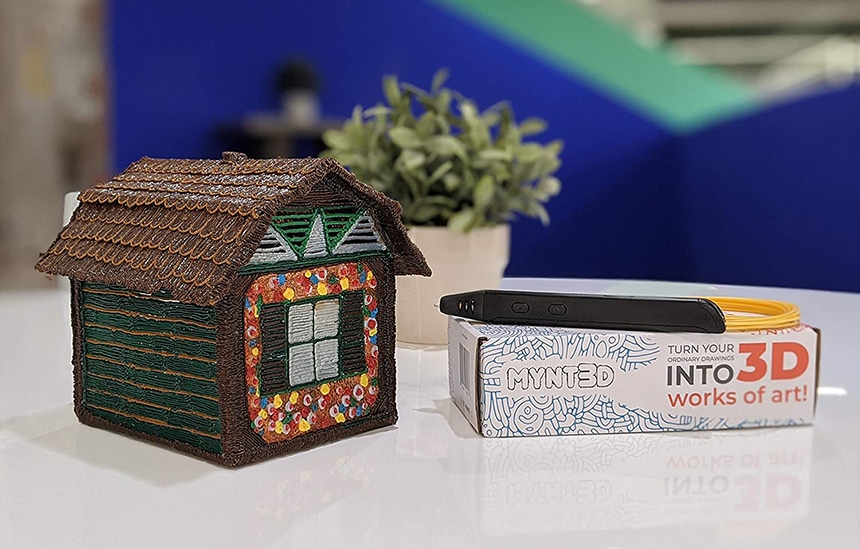
There are different types of plastic with varied melting temperature as well as their own strengths and drawbacks.
Acrylonitrile butadiene styrene (ABS) is popular because it is affordable and easy to harden and shape. However, it requires high working temperature of 190° C to 260° C, and some of the chemicals used to synthetically form this brittle plastic are not environmentally friendly. The high extrusion temperature is convenient for hobbyists with more control over the flow rate and experience with different textures, but the tip and molten plastic may pose risk for young beginners.
Polylactic Acid (PLA) is a form of plant-based polymer that melts at temperature range of 170° C to 230° C. The soft plastic is malleable, environmentally safe, and odorless.
Polycaprolactone (PCL) which makes polyurethane liquefies at 70° C to 100° C. The food grade plastic is biodegradable although it costs much more than PLA and ABS.
Flexy, Flexible, and Flex plastic refer to Thermoplastic Polyurethane (TPU) powder, which retains its flexibility after being shaped for a silky smooth texture. Its downside is the plastic smell.
Photopolymer is a type of plastic only used in specific pens. Instead of using heat to soften it for sculpturing, the already soft plastic utilizes ultraviolet light for bonding to maintain its structural properties.
The most child-safe plastic found in the best 3D pen for kid beginners is PCL such as the non-toxic and biodegradable proprietary 3Doodler Start plastic filaments. It requires minimal heat to melt and cools and hardens rapidly to avoid scalding.
For the 3Doodler Start Series, which makes the best 3D printing pen for kids, the Company specifically cautions customers against using filaments other than the recommended proprietary ones to avoid damaging the pen and voiding the warranty. This is done to ensure the pen remains child-friendly, non-toxic, and eco-friendly as marketed. However, owners of other Series like Create are free to use ABS, PLA, and Flexy materials as well. Compatibility with different types of plastic offers you more options to refill with filaments that match your budget, skills, and projects.
Owing to their high cost, wood and nylon are less common materials in the best value 3D pen for kids, but you can find them in mid and high-priced models.
After reviewing the recommended age, the temperature setting is probably the next most important safety feature to look for in the best 3D pen for kids and beginners.
Children are curious by nature and prone to burns if allowed to handle heated tips, and novices are likely to be inexperienced in setting the temperature just right that it is not too high that it extrudes too much plastic or too low that it clogs, lumps up or hinders a smooth flow.
However, experienced designers would welcome high temperatures they can adjust and settings they can tweak to have more control of the thickness, consistency, and flowing speed of the ejected plastic. Increasing the speed yields faster or continuous flow that can fill up spaces, if need be, in your design while a slow output lets you create detailed patterns and effects.
Since plastic strands are heated and ejected from a tip into the air or surface you are drawing on, child-targeted pens use various ways to promote safety; 3Doodler Start Essentials uses external parts, including the tip, that do not heat up while other models utilize retractable nozzles to prevent accidental burning of anything or anyone.
Speed and temperature settings are selected with stepless sliders, buttons with labeled notches, or from the touchscreen displays, which may also indicate the type of plastic strand in current use.
Power Source: Usually, the best 3D pens for kids and beginners can be charged beforehand and then unplugged during operation. For instance, 3Doodler Start comes with a micro USB charging cable and a battery pack that produces minimum working time of 15 minutes when fully charged. Such models generally use plastic that melts in low heat. On the other hand, MYNT3D Super 3D Pen includes a USB cord and a 100-240V AC 50/60Hz A/C adapter to connect it to an outlet for use. It needs to be plugged in to operate it at high temperatures of 410°F for ABS and 374°F for PLA filaments. If you can’t find a wall outlet, only use laptops that can generate the required output of 2000 mA.
Controls: Single button control would be the best for a 3D printing pen for kids because it is easy to learn and convenient to operate. Advanced pens for older kids and hobbyists may have separate controls for speed, temperature, and for feeding and ejecting plastic strands.
Display: A well-lit display shows you the type of filament in use and the current speed and temperature. Some come with intuitive interfaces that allow you to select settings as well as monitor them. Organic light-emitting diode (OLED) is often featured in the best 3D printing pens for kids because, compared to LED, it has higher brightness and contrast, broader view, and color range, and it uses less energy. MYNT3D Professional Printing 3D Pen is one of the models with a large OLED display.
Certifications: MYNT3D Super 3D Pen boasts of approval by RoHS, CE and FCC, which set and govern safety standards to ensure the products are non-toxic for the intended users and high-quality in energy and performance.
Warranty: Any reputable brand worth its name would offer a substantial warranty period to protect your purchase from manufacturing defects. This is why it is unsurprising that 3Doodler which invented 3D pens has one of the best replacement policies in the industry. The Company has a free replacement policy of 365 days for their customers. Remember to use only recommended refills to adhere to the warranty terms.
3Doodler Start Essentials is made by the Company that introduced the first 3D pen. So, you are assured of quality and also access since the products are made in USA. The 3D pen for kids and beginners uses biodegradable plastic and non-heating external parts that are child-safe and a diverse app with several stencils and tutorials.
MYNT3D Professional Printing 3D Pen provides the best value 3D pen for older kids aged 7 years and above. It boasts of a large display, speed, and temperature control, and support for ABS, PLA, and other filaments with a diameter of 1.75 mm and melting temperature of 140°C to 230° C.
Our third pick for the best 3D printing pen for kids is PIKA3D Super 3D Printing Pen. It comes with 4 colors of PLA filament refill and features variable feed speed, adjustable temperature settings, and an OLED display.
